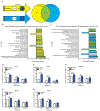Wolfram syndrome 1 gene regulates pathways maintaining beta-cell health and survival
- PMID: 32060407
- PMCID: PMC7286786
- DOI: 10.1038/s41374-020-0408-5
Wolfram syndrome 1 gene regulates pathways maintaining beta-cell health and survival
Abstract
Wolfram Syndrome 1 (WFS1) protein is an endoplasmic reticulum (ER) factor whose deficiency results in juvenile-onset diabetes secondary to cellular dysfunction and apoptosis. The mechanisms guiding β-cell outcomes secondary to WFS1 function, however, remain unclear. Here, we show that WFS1 preserves normal β-cell physiology by promoting insulin biosynthesis and negatively regulating ER stress. Depletion of Wfs1 in vivo and in vitro causes functional defects in glucose-stimulated insulin secretion and insulin content, triggering Chop-mediated apoptotic pathways. Genetic proof of concept studies coupled with RNA-seq reveal that increasing WFS1 confers a functional and a survival advantage to β-cells under ER stress by increasing insulin gene expression and downregulating the Chop-Trib3 axis, thereby activating Akt pathways. Remarkably, WFS1 and INS levels are reduced in type-2 diabetic (T2DM) islets, suggesting that WFS1 may contribute to T2DM β-cell pathology. Taken together, this work reveals essential pathways regulated by WFS1 to control β-cell survival and function primarily through preservation of ER homeostasis.
Conflict of interest statement
Disclosure/Conflict of Interest
The authors declare no competing interests relevant to this article.
Figures





References
-
- Cnop M, Welsh N, Jonas JC, Jorns A, Lenzen S, Eizirik DL. Mechanisms of pancreatic beta-cell death in type 1 and type 2 diabetes: many differences, few similarities. Diabetes 2005;54 Suppl 2:S97–107. - PubMed
-
- Donath MY, Ehses JA, Maedler K, Schumann DM, Ellingsgaard H, Eppler E, et al. Mechanisms of beta-cell death in type 2 diabetes. Diabetes 2005;54 Suppl 2:S108–113. - PubMed
-
- Harding HP, Ron D. Endoplasmic reticulum stress and the development of diabetes: a review. Diabetes 2002;51 Suppl 3:S455–461. - PubMed
-
- Inoue H, Tanizawa Y, Wasson J, Behn P, Kalidas K, Bernal-Mizrachi E, et al. A gene encoding a transmembrane protein is mutated in patients with diabetes mellitus and optic atrophy (Wolfram syndrome). Nat Genet 1998;20(2):143–148. - PubMed
Publication types
MeSH terms
Substances
Grants and funding
LinkOut - more resources
Full Text Sources
Molecular Biology Databases
Research Materials

